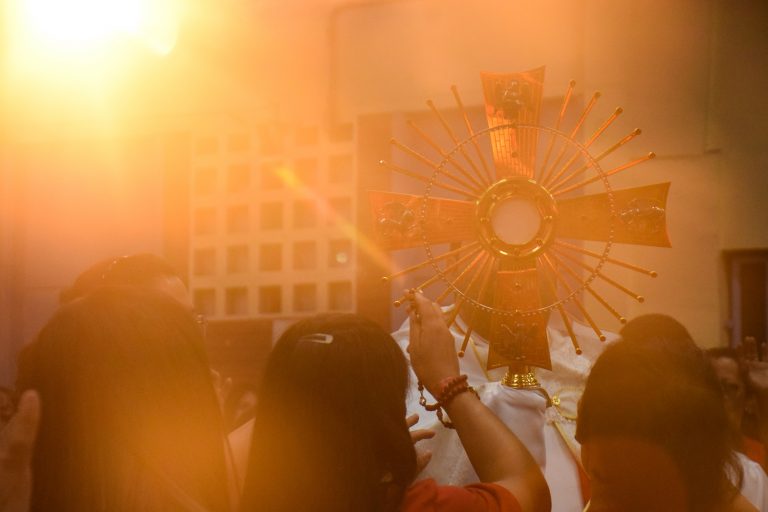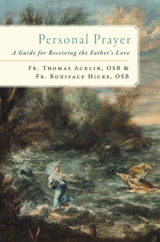By Fr. Boniface Hicks, OSB, and Fr. Thomas Acklin, OSB
Fr. Boniface Hicks, OSB, is a Benedictine monk of St. Vincent Archabbey in Latrobe, Pennsylvania. He has provided spiritual direction for many men and women, including married couples, seminarians, consecrated religious, and priests.
Fr. Thomas Acklin, OSB, is is a Benedictine monk of Saint Vincent Archabbey in Latrobe, Pennsylvania. He is a psychoanalyst as well as a spiritual director. Fr. Acklin has been a professor and spiritual director at Saint Vincent Seminary, where he also served as rector.

The highest form of devotion is actually more than a devotion: Eucharistic adoration. This personal, devotional prayer is also truly a form of liturgical prayer. Because the Eucharist comes only from the Church’s Liturgy, there is always a liturgical dimension to Eucharistic adoration.
The adoration of the Blessed Sacrament exposed in the monstrance is truly a form of liturgy. In fact, the requirement that someone must always be present when the Eucharist is exposed makes more sense when thinking of the adoration of the Blessed Sacrament as a liturgy, because, for a liturgy (meaning literally “work of the people”) to be carried out, there must be at least one person who remains present. In light of this, the practice of perpetual adoration, which has spread broadly throughout the world like never before, is particularly spectacular, because it means that where there is perpetual Eucharistic adoration, there are perpetual liturgies taking place that are shared among whole parishes and communities. And, because the liturgy is always efficacious, ex opere operato, the mere presence of the faithful with Jesus exposed in the monstrance has a profound effect on renewing the Church and transforming the world.
Eucharistic devotion is founded on the teaching of Jesus that the consecrated bread of the Mass is truly His Body and Blood (John 6:48–58). The Church has reaffirmed this throughout the centuries and highlighted this unique Eucharistic presence in a significant way at the Second Vatican Council. The Constitution on the Sacred Liturgy speaks of four ways that Jesus is present in the Mass: “He is present in the sacrifice of the Mass, not only in the person of His minister, ‘the same now offering, through the ministry of priests, who formerly offered himself on the cross’, but especially under the Eucharistic species.” The remark that He is especially present in the Eucharistic species points to a realism and concreteness that is not part of the other forms of His Presence. Moreover, the Eucharist remains the Body and Blood, Soul and Divinity of Christ beyond the time of the celebration of the Mass and has always been preserved in a special place with special reverence to administer to the sick. Furthermore, as long as the Eucharist has been preserved, It has been adored.
Because this is the only way that Jesus is substantially present, in His Body and Blood, substantially present and preserved in the consecrated host, it always holds a special place in the devotion of the Church and the devotion of the faithful. This makes sense naturally when viewed from a relational perspective. As much as we love to talk with a loved one on the phone, we always prefer to be with our beloved in person. In the Eucharist, the Divine Bridegroom remains bodily present to us. This is a great help for us as human beings, since we always start with our senses as our starting point for encounter. The opportunity to raise our eyes to the Eucharist—whether in the monstrance or in the Tabernacle— serves to focus our attention and lift our hearts at the same time. Furthermore, although we know that God is always with us, it always helps us to encounter Him in a concrete location. In the Eucharist, in a profound way, we can find God.
It is critical to approach prayer with a concreteness and realism. Our faith in the Real Presence of Christ in the Blessed Sacrament fully supports and encourages such concreteness. When we are in the presence of the Blessed Sacrament, we can say that is really Jesus! There He is! Eucharistic adoration gives us the opportunity to enter into a real communion of persons with Jesus in a spiritual way that also incorporates our senses. Gazing upon Him uses our physical eyes and orients our posture in prayer.
As we come before the real and visible Presence of the Almighty, we humble ourselves before Him through genuflection or even prostration. The Greek word for adoration—proskynesis—speaks to that posture. We prostrate before the Creator out of recognition that we are unworthy and sinful creatures, and He is pure goodness, beauty, truth, and the source of all Being. Our natural and initial gesture in coming before God is humble submission. At the same time, our prayer is not truly Christian until we allow Him to raise us up. We come to Him in humble submission and He raises us up to an intimate equality as the Latin word for adoration—adoratio—tells us. “The Latin word for adoration is ad-oratio—mouth to mouth contact, a kiss, an embrace, and hence, ultimately love. Submission becomes union, because He to whom we submit is Love. In this way submission acquires a meaning, because it does not impose anything on us from the outside, but liberates us deep within.”
Ultimately, we are also drawn not only to see but to “taste and see” the goodness of the Lord (Ps 34). We adore the Eucharist, which we also call “Holy Communion.” Amazingly, God is always drawing us into deeper intimacy, deeper communion with Himself where a much fuller contemplative union with Him can be realized. He dignifies us by the Love that He freely pours out on us and into us. He divinizes us as He fills us with Himself. Knowing that the ultimate desire of the Lord and His call to us is full Communion orients our prayer time in adoration. Our time in Eucharistic adoration always includes a dimension of longing. We are invited to feel our thirst for Him and also to feel the deep longing thirst He has for us, which can truly be called eros. What divine madness has moved Him to become bread for us? He becomes so humble and small, so vulnerable, so that we can eat Him. Like a father who offers a finger to his baby or, even more poignantly, a mother who offers her breast, God makes it possible for us to eat Him and make Him a part of ourselves.
You Might Also Like
 Prayer is at the heart of the Christian life. Given that we are weak and even sinful human beings, how can it be that God has anything to do with us? What does it mean to have a personal relationship with God? Why is God so silent and hidden? How do we grow in prayer? Personal Prayer: A Guide for Receiving the Father’s Love brings the depth of human experience together with the Catholic tradition of prayer to present the path to an intimate and vulnerable relationship with God.
Prayer is at the heart of the Christian life. Given that we are weak and even sinful human beings, how can it be that God has anything to do with us? What does it mean to have a personal relationship with God? Why is God so silent and hidden? How do we grow in prayer? Personal Prayer: A Guide for Receiving the Father’s Love brings the depth of human experience together with the Catholic tradition of prayer to present the path to an intimate and vulnerable relationship with God.